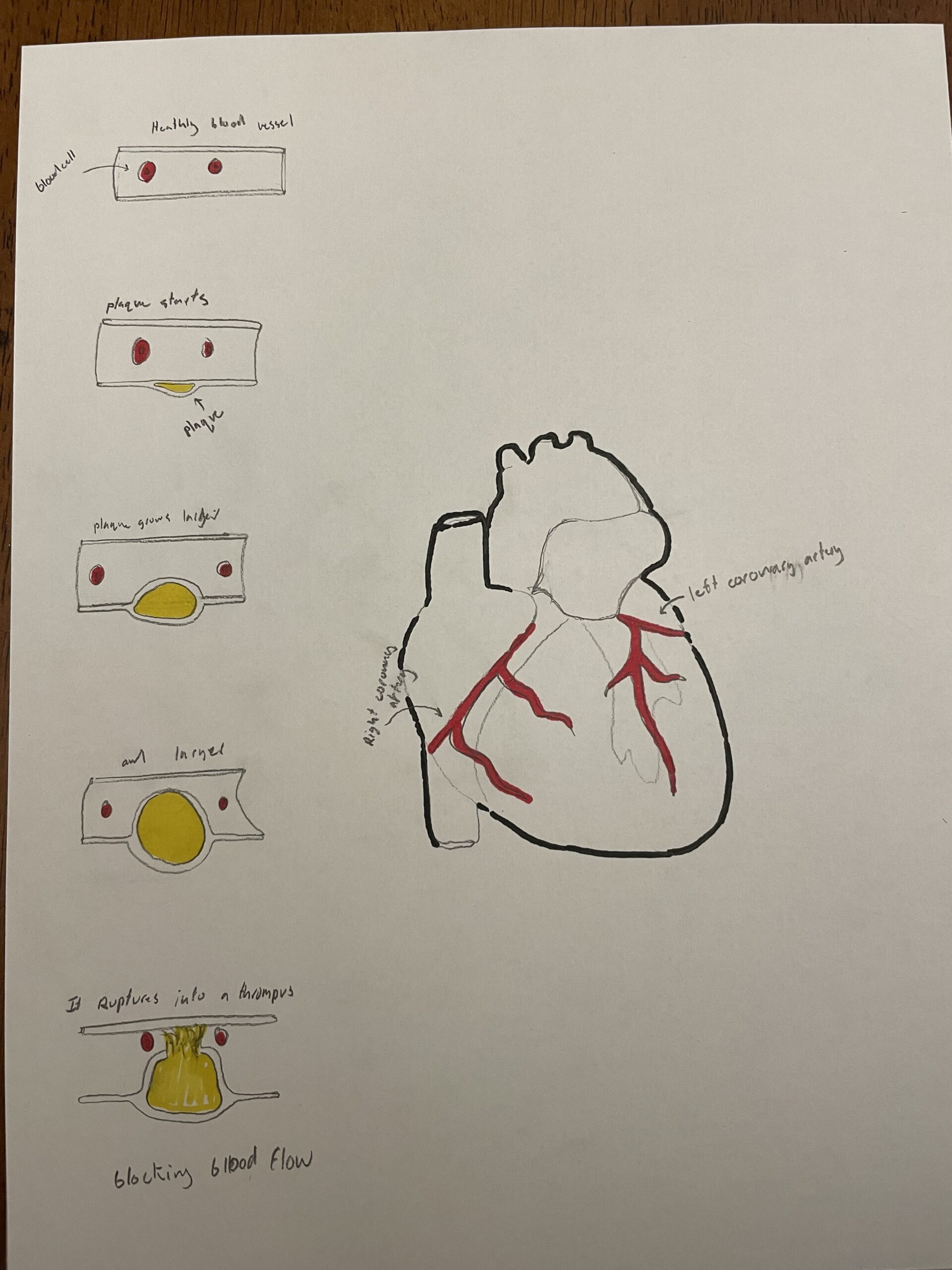Atherosclerosis Is a form of Arteriosclerosis. Arteriosclerosis is when blood vessels that transport nutrients and oxygen around the body lose their flexibility and thicken,“sometimes restricting blood flow to the organs and tissues. Healthy arteries are flexible and elastic. But over time, the walls in the arteries can harden, a condition commonly called hardening of the arteries.”(Mayoclinic). Atherosclerosis is a little different. Atherosclerosis is a buildup of plaque in the artery walls specifically. There are around thirty arteries in the human body that can be affected by atherosclerosis. The arteries that are most commonly affected by atherosclerosis are the coronary arteries. There are two coronary arteries and they supply oxygenated blood to the heart. When these arteries get atherosclerosis it is called coronary artery disease. Coronary artery disease is the number one type of heart disease in the United states. Around 400,000 people a year are killed by this disease. Heart disease in general is the number one killer of Americans with coronary artery disease being number one. The plaque in atherosclerosis is made from fatty deposits on the walls of the artery. The plaque in the arteries slowly accumulates over time. The leading theory behind the cause of atherosclerosis involves LDL cholesterol. LDL stands for low density lipoprotein. In a healthy artery all of the blood flows through smoothly and everything works great until plaque creates a bulge. In the coronary artery the blood flows through the hollow in the middle called the lumen. The walls of the blood vessel are first lined with endothelium, then the tunica intima then a little further the tunica media which also has some smooth muscle cells to help the arteries contract. The problem that causes plaque build up is thought to happen when there is endothelial dysfunction and LDL cholesterol is deposited into the tunica intima. In the tunica intima the cholesterol oxidizes. This oxidation results in the endothelium cells making white blood cell receptors. The white blood cells then adhere to the endothelium and go into the tunica intima. Once there the white blood cells turn into macrophages and eat the oxidized LDL cholesterol. Once the macrophages eat the oxidized LDL they turn into foam cells. These foam cells produce chemicals that lead to smooth muscle from the tunica media to proliferate the tunica intima. This stimulates a lot of collagen production which can make the vessels stiffer and the plaque a little bit harder. When the foam cells die they release all of their fatty lipid content. This causes the plaque to grow in size. Once the plaque gets big enough it starts to restrict blood flow a little. The big problem arises when the endothelium contains all of the plaque in the artery walls ruptures and makes a thrombus. The plaque explodes all over and the blood in the vessel clots which can completely block the flow of blood. This causes a heart attack and makes atherosclerosis very deadly. This relates to objective 42 which is about the heart’s structure and function. The coronary arteries are what supplies blood to the heart muscles for it to have the nutrients and oxygen to function and pump blood to other body parts. If the heart isn’t getting its blood due to a blockage caused by a thrombus it will stop working properly, and the person will have a heart attack. I drew pictures of Plaque slowly growing in the walls of the artery until it ruptures. I also drew a heart and show where the coronary arteries are.
References
Mayo Foundation for Medical Education and Research. (2022, July 1). Arteriosclerosis / atherosclerosis. Mayo Clinic. Retrieved April 21, 2023, from https://www.mayoclinic.org/diseases-conditions/arteriosclerosis-atherosclerosis/symptoms-causes/syc-20350569
Mayo Foundation for Medical Education and Research. (n.d.). Development of atherosclerosis. Mayo Clinic. Retrieved April 21, 2023, from https://www.mayoclinic.org/diseases-conditions/arteriosclerosis-atherosclerosis/multimedia/development-of-atherosclerosis/img-20005848
Owsiany, K. m. (n.d.). Revealing the origins of foam cells in atherosclerotic lesions. Retrieved April 21, 2023, from https://www.ahajournals.org/doi/10.1161/ATVBAHA.119.312557
Yu XH;Fu YC;Zhang DW;Yin K;Tang CK; (n.d.). Foam cells in atherosclerosis. Clinica chimica acta; international journal of clinical chemistry. Retrieved April 21, 2023, from https://pubmed.ncbi.nlm.nih.gov/23782937/



Owen’s project is about Atherosclerosis. He describes what atherosclerosis is and how it affects the body. Atherosclerosis is a buildup of plaque on the artery walls. The buildup of plaque will harden and cause issues. When the buildup gets bad enough it can explode and completely block the flow of blood causing a heart attack. That is what makes atherosclerosis deadly. Owen’s art is a picture of the different stages of atherosclerosis. The first image shows a healthy artery. A healthy artery has no obstructions and blood is able to move freely. This is the type of artery we want. The second through fourth images show the growth of plaque in the artery wall. As the plaque grows it makes it harder and harder for the blood to flow through. This can cause stress on the heart. The last image shows the plaque bursting creating a thrombus. This causes complete blood flow and can kill the person. I learned that atherosclerosis is a form of arteriosclerosis. They are slightly different because atherosclerosis causes buildup and hardening of plaque in the arteries and arteriosclerosis is when blood vessels that transport nutrients and oxygen around the body lose their flexibility and thicken.